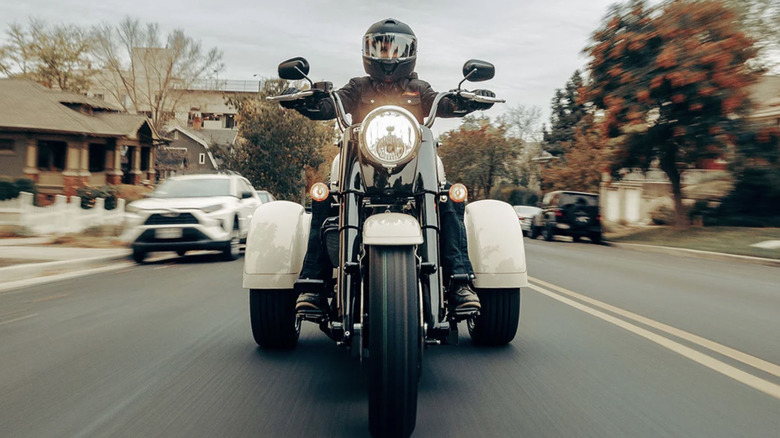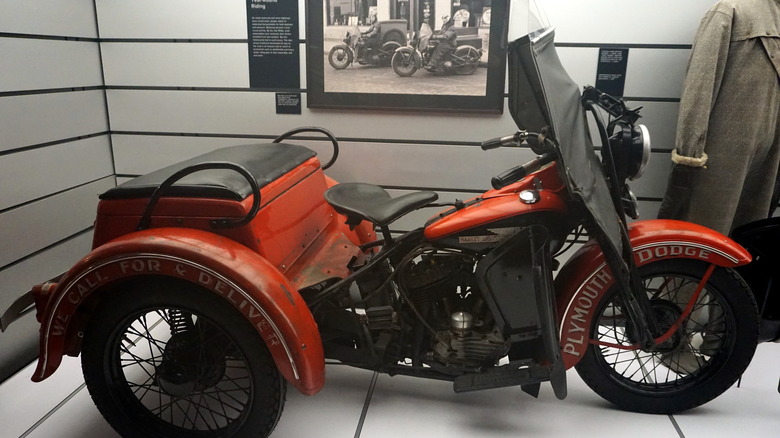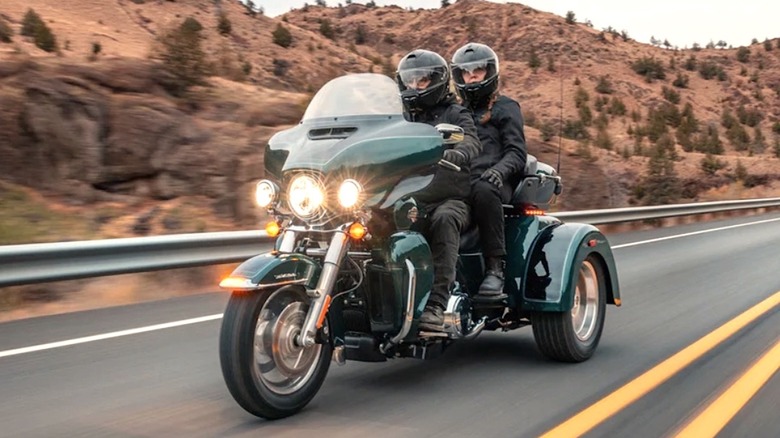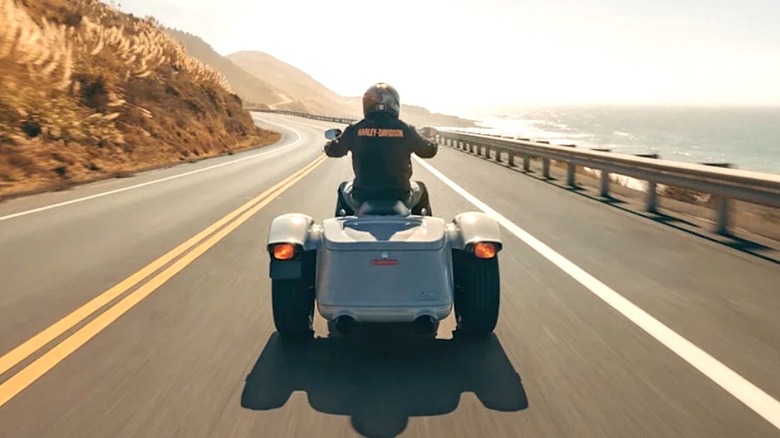3 Of The Best Trikes Ever Built By Harley-Davidson
For those who prefer their primary mode of transportation be of the two-wheeled persuasion, Harley-Davidson is essentially an end-all be-all sort of brand name. There's good reason for that, as the Milwaukee-based manufacturer has delivered some of the most celebrated bikes to ever hit the road in the century-plus since the release of its first motorcycle.
Of course, not all of Harley-Davidson's black top ready creations have been set on only two wheels. You may not realize it, but the renowned bike-maker has been in the trike game almost as long as it's been making motorcycles, with the Harley-Davidson team putting its first trike on the road in 1913. For those not in the know, the term "trike" essentially means a motorcycle with three wheels instead of two, like a tricycle but significantly cooler. As with its motorcycles, Harley's approach to the trike has changed dramatically since the two-in-the-front, one-in-the-back wheel design of The Forecar.
In fact, The Forecar was the last Harley-Davidson build to boast that unusual trike design, with subsequent builds going to the more traditional two-in-the-back and one-in-the-front look we've come to know from the brand. In the years since making that move, the Harley-Davidson design team has continued to evolve the look and functionality of their trikes, and has delivered a few unforgettable builds along the way. Here's a look at a few of the more memorable trikes Harley-Davidson has manufactured.
Harley-Davidson Servi-Car
Many of the early Harley-Davidson trikes were, understandably, used as delivery vehicles, and not long after the Forecar was released, the company developed a trike build that transformed a re-designed sidecar into a cargo box. That model was aptly dubbed the Package Truck, and was reportedly even utilized by postal workers after hitting the streets in 1915. As intriguing as some of those early Harley-Davidson trikes were — there was briefly even a build with retractable wheels in the 1920s — a case could be made that H-D didn't quite get the trike right until 1931 when the company released the famed Servi-Car.
The Servi-Car joined the Harley-Davidson lineup just two years after Harley-Davidson unleashed its iconic Flathead V-Twin engine, and it would indeed be powered by the game-changing power source for most of its production run. Just for the record, the Servi-Car was such a hit upon release, it ended up being in production for just over four decades, ranking it among the longest-tenured builds in Harley-Davidson history. In 1964, the Servi-Car also became the first Harley build to feature an electric starter, beating the legendary Electra-Glide to the punch by about a year.
As for the trike's popularity, the Servi-Car reportedly became an ideal mode of transport for businesses needing to make crosstown deliveries, with some savvy businessmen reportedly utilizing its storage box as an advertising space. For those reasons and more, Harley-Davidson kept the trike in production until 1973. And yeah, it still ranks among the best-looking trikes ever made.
[Featured image by Michael Barera via Wikimedia Commons | Cropped and scaled CC BY-SA 4.0]
Harley-Davidson Tri-Glide Ultra
As it happens, when Harley-Davidson pulled the plug on the Servi-Car in 1973, it upended its entire trike program. In fact, the brand ultimately exited the three-wheeled motorcycle arena altogether, leaving other manufacturers to tinker with trikes for the next four-and-a-half decades. There were, of course, trikes with the Harley-Davidson badge hitting the streets in the 1970s and beyond, but they were specialty builds that were chopped up and modified on the owner's dime. Harley-Davidson didn't get back into the trike game proper until 2009, doing so in high style with a steady-rolling, long-haul ready cruiser dubbed the Tri-Glide Ultra Classic.
As you might've ascertained from the trike's batwing fairing, the three-wheeled build likely took a few design cues from Harley-Davidson touring builds, in particular the brand's luxury touring legend, the Electra-Glide. Indeed, the Tri-Glide appears to simply fix the front end of that predecessor onto a trike chassis in service of making a three-wheel machine that had far more on its mind than crosstown deliveries.
With its fully backed and padded passenger seat and ample storage capacity, it's clear the Tri-Glide was likely targeting the touring bike sector, offering a more luxurious experience for up to two riders looking to log some serious time in the saddle. Likewise, the three-wheel setup surely made the Tri-Glide as appealing to newer riders as seasoned saddle vets. Upon its '09 debut, the Tri-Glide all but single-handedly re-ignited Harley-Davidson's long-abandoned prominence in the trike scene. Fittingly, the build has remained a staple in the company's three-wheeled lineup ever since.
Harley-Davidson Freewheeler
Harley-Davidson likely opted to hedge a bit and see if the Tri-Glide Ultra Classic had staying power on the scene before adding another three-wheeled vehicle to its lineup. As it was, the Tri-Glide was its only trike for the better part of a five-year stretch between '09 and 2014. But the legendary manufacturer impressed again when it debuted the Freewheeler for the 2015 model year.
One look at even the early versions of the Freewheeler makes clear that Harley bosses were not looking to duplicate the things that made the Tri-Glide a success when they designed it. Rather, the bike boasts a leaner, meaner frame and a minimalist fairing more in line with some of the brand's cruising builds, with H-D, perhaps, looking to catch the eye of both cruiser aficionados and new riders looking alike. Whatever the case, with its no frills front end and stylishly simplistic bobtail rear end design (highlighted by delightfully bobbed rear fenders), the Freewheeler arguably became one of the more distinctive looking bike's in the Harley stable, even if it will likely never rank among the brand's best builds.
The trike continues to stand out in the Harley-Davidson lineup today, largely because the Freewheeler hasn't dramatically changed its overall look in the decade-plus since its debut. There are, of course, some Harley die-hards who just can't get behind the whole three-wheel scene, if only because it limits the danger associated with two-wheel rides. But if you're looking for a Harley that fronts some hot rod attitude with the luxury of a third wheel safety net, the Freewheeler checks all the boxes.



